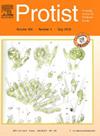The end of a winding path: The anaerobic ciliate Spirorhynchus is a member of the class Muranotrichea
IF 2.1
3区 生物学
Q4 MICROBIOLOGY
引用次数: 0
Abstract
Ciliated protists (Ciliophora) are important members of freshwater, brackish, marine, and hypersaline benthic microbial communities. As part of our broader studies of anaerobic protists, we encountered a ciliate in hypoxic sediment samples from three geographically distant saline habitats and identified it as Spirorhynchus verrucosus Cunha, 1915. This highly unusual ciliate has a complicated nomenclatural and taxonomic history and has been assigned to the armophorean family Metopidae. The distinctive cell shape and unique arrangement of ectosymbionts allows identification of this species by in vivo observation. Two populations of another ciliate, found in deep-sea sediments, were recognized as a morphologically and genetically distinct but not yet formally described Spirorhynchus species. Muranotrichea Rotterová et al., 2020 is a recently established class of obligately anaerobic marine ciliates that bear prokaryotic ectosymbionts, and includes one family with two genera and three species. Phylogenetic analyses, based on the first 18S rRNA gene sequences from the genus, place Spirorhynchus in Class Muranotrichea. In single-gene trees, Spirorhynchus is monophyletic, branching as the closest relative of a marine environmental sequence and the muranotrichean genus Thigmothrix, with which Spirorhynchus also shares some morphologic similarities. Here, we also provide the first protargol impregnations and scanning electron microscopy images from Spirorhynchus.
蜿蜒路径的尽头:厌氧纤毛虫螺舌龙是Muranotrichea纲的一员。
纤毛原生生物是淡水、半咸水、海洋和高盐底栖微生物群落的重要成员。作为我们对厌氧原生生物更广泛研究的一部分,我们在三个地理位置遥远的含盐栖息地的缺氧沉积物样本中遇到了一种毛虫,并将其鉴定为Spirorhynchus verrucosusCunha, 1915。这种极不寻常的纤毛虫有一个复杂的命名和分类历史,并被分配到甲虫科。独特的细胞形状和独特的排列外共生体允许通过体内观察来识别这个物种。在深海沉积物中发现的另一种纤毛虫的两个种群,被认为在形态和遗传上是不同的,但尚未被正式描述。Muranotrichea rotterov等人,2020是最近建立的一类专性厌氧海洋毛虫,具有原核外共生体,包括一个科,两属三种。根据该属18S rRNA基因序列的系统发育分析,螺旋藻属属属归属于Muranotrichea纲。在单基因树中,Spirorhynchus是单系的,分支是海洋环境序列和muranotrichean属Thigmothrix的近亲,与后者也有一些形态上的相似之处。在这里,我们也提供了第一个原石醇浸渍和扫描电镜图像的螺旋藻。
本文章由计算机程序翻译,如有差异,请以英文原文为准。
求助全文
约1分钟内获得全文
求助全文
来源期刊

Protist
生物-微生物学
CiteScore
3.60
自引率
4.00%
发文量
43
审稿时长
18.7 weeks
期刊介绍:
Protist is the international forum for reporting substantial and novel findings in any area of research on protists. The criteria for acceptance of manuscripts are scientific excellence, significance, and interest for a broad readership. Suitable subject areas include: molecular, cell and developmental biology, biochemistry, systematics and phylogeny, and ecology of protists. Both autotrophic and heterotrophic protists as well as parasites are covered. The journal publishes original papers, short historical perspectives and includes a news and views section.
 求助内容:
求助内容: 应助结果提醒方式:
应助结果提醒方式:


